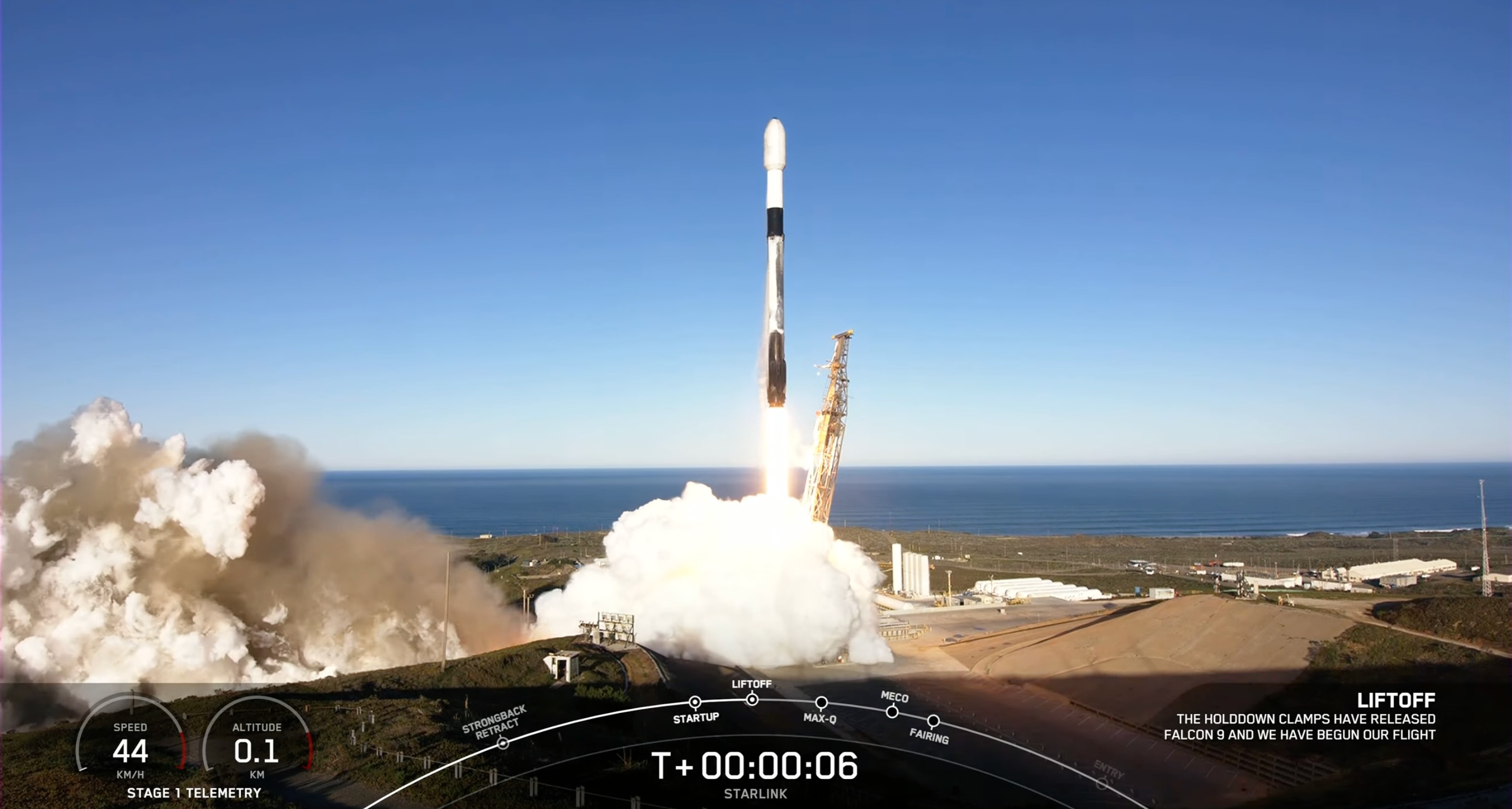A SpaceX Falcon 9 rocket launched 50 spacecraft to orbit on Tuesday (Jan. 31), then came back down to Earth for a pinpoint landing on a ship at sea.
A Falcon 9 topped with 49 Starlink satellites, as well as a rideshare spacecraft from the Italy-based company D-Orbit, lifted off Tuesday from California's Vandenberg Space Force Base at 11:15 a.m. EST (1615 GMT, 8:15 a.m. local California time).
The Falcon 9's first stage came back to Earth about 8 minutes and 45 seconds after launch, touching down softly on SpaceX's Of Course I Still Love You droneship, which was stationed in the Pacific Ocean off the California coast.
Related: 10 weird things about SpaceX's Starlink internet satellites

It was the seventh launch and landing for this particular booster, according to a SpaceX mission description, and the 168th touchdown overall for a SpaceX orbital rocket.
The Falcon 9's upper stage, meanwhile, continued hauling the 50 payloads to low Earth orbit. It deployed D-Orbit's Ion Satellite Carrier Vehicle #9 (SCV009), an orbital transfer craft that carried a diverse set of payloads of its own, on schedule about 58 minutes after liftoff.
"The rideshare hosts payloads from the Munich-based company HPS, U.S. company EBAD, the Swiss institute EPFL and the New Zealand company StardustMe," Kate Tice, SpaceX quality system engineering manager, said during a webcast of Tuesday's launch.
Get the Space.com Newsletter
Breaking space news, the latest updates on rocket launches, skywatching events and more!
The HPS payload is a braking sail designed to help satellites come down from Earth orbit more efficiently, D-Orbit revealed in a press release that was posted on Twitter shortly after launch. EBAD's was a "payload release ring" that carried a spacecraft simulator. EPFL's was a student-developed onboard computer called Bunny, which is part of a larger effort to eventually launch small atmosphere-studying spacecraft for use here on Earth and farther afield, potentially all the way out to exoplanet systems.
StardustMe, meanwhile, provides customers with memorial spaceflights. The company's payload on Tuesday's launch consisted "of a batch of aluminum machined capsules, each carrying a gram of human cremated ashes, contained in an additive-manufactured frame and enclosure," D-Orbit wrote in the press release. "The assembly, permanently fixed to the main core of ION, will eventually re-enter the atmosphere with the host vehicle during decommissioning, providing an ultimate form of space burial."
The Falcon 9 upper stage deployed the 49 Starlink satellites about one hour and 17 minutes after launch as planned, SpaceX confirmed via Twitter.
SpaceX has now launched more than 3,800 Starlink satellites, and the huge constellation will continue to grow for quite some time: The company has permission to loft 12,000 of the internet spacecraft and has applied for approval to deploy about 30,000 more on top of that.
Tuesday's liftoff was the seventh of the year already for SpaceX, and the third Starlink mission of 2023. Though it's still very early, Elon Musk's company is on pace to break its single-year record of 61 orbital launches, which it set last year.
Editor's note: This story was updated at 11:10 a.m. ET on Jan. 29 with the new launch date of Jan. 30. Liftoff had been scheduled for Jan. 29, but SpaceX pushed things back a day to finish prelaunch checkouts. It was updated again on Jan. 31 with news of the successful liftoff, rocket landing and satellite deployment, then again that same day with details about the payloads on the D-Orbit spacecraft.
Mike Wall is the author of "Out There" (Grand Central Publishing, 2018; illustrated by Karl Tate), a book about the search for alien life. Follow him on Twitter @michaeldwall. Follow us on Twitter @Spacedotcom or Facebook.
Join our Space Forums to keep talking space on the latest missions, night sky and more! And if you have a news tip, correction or comment, let us know at: community@space.com.

Michael Wall is a Senior Space Writer with Space.com and joined the team in 2010. He primarily covers exoplanets, spaceflight and military space, but has been known to dabble in the space art beat. His book about the search for alien life, "Out There," was published on Nov. 13, 2018. Before becoming a science writer, Michael worked as a herpetologist and wildlife biologist. He has a Ph.D. in evolutionary biology from the University of Sydney, Australia, a bachelor's degree from the University of Arizona, and a graduate certificate in science writing from the University of California, Santa Cruz. To find out what his latest project is, you can follow Michael on Twitter.









